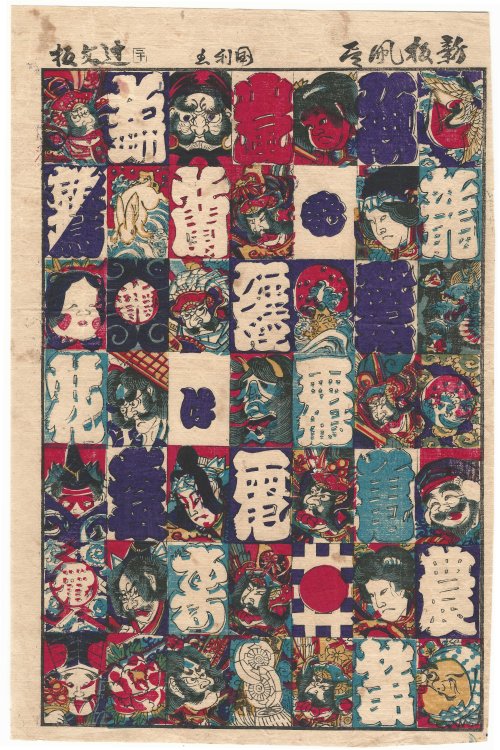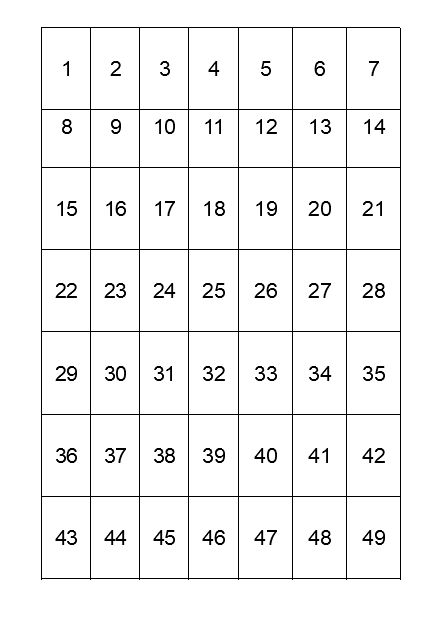| |
KUNITOSHIUtagawa KUNITOSHI(1847 - 1899)'New Comprehensive Collection of Kites' |
|
|
 |

|
New Comprehensive
Selection of Kites
(Shinban-dako jin, аå„J¾¡)
1889
Series - ~
Artist - see Biography
Signature - KUNITOSHI-ga ( ·¼ÌÙ) on upper selvage above design No. 3 and design No. 4
(Shinban-dako jin, аå„J¾¡)
1889
Comment - Uncut single sheet omocha-e, with 49
classical kite designs for Edo
kites or Edo Kaku
kites. The title of the print is written on the selvage above
design No.5 t 7. Please compare this print with the toy
print from KUNIAKI-II
and YOSHIFUJI,
as well as the small edo
kite chiyogami from an unknown woodblock artist of the
Meiji-era.
The designs are as follows:
| Number |
||
| 1 |
Warrior design |
|
| 2 |
"Kanji
kite" ("ji tako", "×Ö„J") |
|
| 3 |
Daruma
face design |
|
| 4 |
"Kanji kite" ("ji tako", "×Ö„J") | |
| 5 |
Kintaro |
|
| 6 |
"Kanji kite" ("ji tako", "×Ö„J") | |
| 7 |
A red sun
with a crane on it. The crane is an important
symbol for long life. The depicted scene is a typical
'hinode tsuru' (ÈÕÄ˳öúQ ) motif. 'Hinode' means
'sunrise', tsuru means 'crane'. The 'hinodetsuro' is
also a traditional motif connected to Asahina. |
|
| 8 |
"Kanji kite" ("ji tako", "×Ö„J") | |
| 9 |
A depiction of the widespread story of the "Rabbit in the Moon". The curly waves are to be intended as 'smoke'. Because of self sacrificing, the Rabbit is sent as a reward to the Moon by Teishakuten. Teishakuten is in 'Western eyes' the Higher Supreme Celestial Being. | |
| 10 | "Kanji kite" ("ji tako", "×Ö„J") | |
| 11 |
Warrior design |
|
| 12 |
circular "Kanji
kite" ("ji tako", "×Ö„J") design |
|
| 13 |
Warrior design |
|
| 14 |
"Kanji kite" ("ji tako", "×Ö„J") design | |
| 15 |
Okame, the Goddess of dawn, mirth and revelry, supposed to be a lucky charm | |
| 16 |
A variation of the Japanese flag, with kanji written above
the sun circle |
|
| 17 |
Warrior design |
|
| 18 |
"Kanji kite" ("ji tako", "×Ö„J") design | |
| 19 |
A depiction of the widespread story of
the "Rabbit in the
Moon". Despite the "western view" of the red
ball as seen as the Sun, it is indeed the Moon,
therfore the night blue background. The curly waves
are to be intended as 'smoke'. The Rabbit is only
hinted at behind the curly 'waves'.Compare No.9 |
|
| 20 |
"Kanji kite" ("ji tako", "×Ö„J") design | |
| 21 |
Dragon scene | |
| 22 |
"Kanji kite" ("ji tako", "×Ö„J") design | |
| 23 |
Warrior design |
|
| 24 |
"Kanji kite" ("ji tako", "×Ö„J") design | |
| 25 |
Ghost design |
|
| 26 |
"Kanji kite" ("ji tako", "×Ö„J") design | |
| 27 |
Warrior design |
|
| 28 |
A depiction of the widespread story of
the "Rabbit in the
Moon". Compar No.9. |
|
| 29 |
Funny face design |
|
| 30 |
"Kanji kite" ("ji tako", "×Ö„J") design | |
| 31 |
Warrior design |
|
| 32 |
"Kanji kite" ("ji tako", "×Ö„J") design | |
| 33 |
A scene of the historical tale "Romance of the Three Kingdoms," a story about the three warring kingdoms in China during the third century, often played in Kabuki theatres. The warrior is probably Kan'u (évÓð), a general of Eastern Han. | |
| 34 |
"Kanji kite" ("ji tako", "×Ö„J") design | |
| 35 |
A depiction of Hotei, one of the
Seven Lucky Gods |
|
| 36 |
A variation of the Japanese flag, with kanji written above
the sun circle. Compare No.16. |
|
| 37 |
A grumpy old man |
|
| 38 |
"Kanji kite" ("ji tako", "×Ö„J") design | |
| 39 |
Warrior design |
|
| 40 |
An often seen variation of the Japanese flag | |
| 41 |
Warrior design |
|
| 42 |
"Kanji kite" ("ji tako", "×Ö„J") design | |
| 43 |
Shitadashisanbas¨ tako (Éà³ö¤·Èý·¬ÛÅ„J) or
Yokosuka kite ( ºáíšÙR„J) design |
|
| 44 |
Floral design |
|
| 45 |
Warrior design |
|
| 46 |
Lantern design |
|
| 47 |
Warrior design |
|
| 48 |
"Kanji kite" ("ji tako", "×Ö„J") design | |
| 49 |
A design depicting 'Hyotoko' (»ðÄÐ or ¤Ò¤ç¤Ã¤È¤³) with his puckered and bent look. He is the male counterpart of Okame. |
Please compare this print with the toy print from KUNIAKI-II and YOSHIFUJI, as well as
the small edo
kite chiyogami from an unknown woodblock artist of the
Meiji-era.
Series - ~
Artist - see Biography
Signature - KUNITOSHI-ga ( ·¼ÌÙ) on upper selvage above design No. 3 and design No. 4
Publisher - Torisugiru? on
upper selvage above design No. 1 and design No. 2
Image Size - 23.3 X 35.3 cm (9 1/15" x 28")
Condition - single sheet; nishiki-e (cloured woodblock); omocha-e (toy print); vertical ôban (ôban tate-e);
Image Size - 23.3 X 35.3 cm (9 1/15" x 28")
Condition - single sheet; nishiki-e (cloured woodblock); omocha-e (toy print); vertical ôban (ôban tate-e);
Copyright 2008 ff: Hans P. Boehme